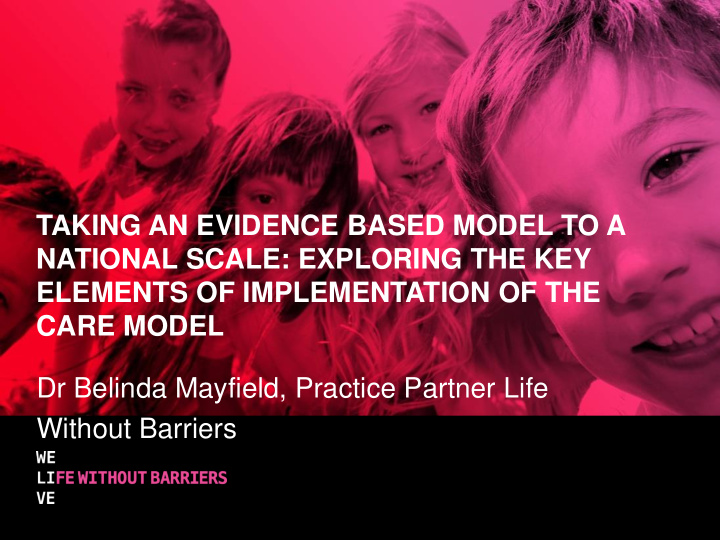



TAKING AN EVIDENCE BASED MODEL TO A NATIONAL SCALE: EXPLORING THE KEY ELEMENTS OF IMPLEMENTATION OF THE CARE MODEL Dr Belinda Mayfield, Practice Partner Life Without Barriers
OVERVIEW • Why a Model? • Why the CARE Model • Overview of CARE and Therapeutic Crisis Intervention (TCI) • Key elements of implementation • Benefits and challenges of going to scale • Examples of baseline data 2
WHY EVIDENCE? TO HELP US CHANGE THE LEARNING CULTURE WAY WE DO THINGS • Supporting our staff to engage with • Remaining engaged with research the ‘why’ behind what we do, and developments and the evidence base encouraging innovation. to find better ways of doing things • Making sure our people are • Supporting the growth of evidence- equipped to be their best based practice and programs EVIDENCE Ensuring our services have a Knowing what we want to achieve program logic, outcome measures and how this changes lives for the and the time and space to evaluate better so we can plan how to get them there RESEARCH, EVALUATION & FOCUS ON OUTCOMES CONTINUOUS IMPROVEMENT 3
WHY A MODEL? Theoretical Knowledge Personal Empirical Knowledge Knowledge Professional Decisions Practice Procedural Knowledge Knowledge Ref: Drury-Hudson, 1997 4
• Our purpose is to partner with people to WHY A change lives for the better; fundamental MODEL? obligation to always try to do the best for our clients • We want to close the gap between what we know works best and what is done every day • We know that using evidence to guide our service delivery can improve outcomes for the people with whom we partner • A model synthesises research, theory and practice knowledge • Advantages of shared understanding; shared language 5
• Fit’ with LWB values WHY • Level of available research evidence CARE? • Only model with explicit theory of change • Builds on our existing use of TCI • Accessibility • Contributes to growing the research The California Evidence-Based Clearinghouse for Child Welfare has rated the CARE model as promising research evidence and highly relevant to child welfare practice. 6
CARE IS: A principle-based practice model designed to guide staff and carers practice and interactions with children in order to create the conditions for change in children's lives. Core Concepts • Best Interests of the Child • Struggle for Congruence • Evidence Informed Program Model 7
• Relationship based CARE PRINCIPLES • Developmentally focused • Family involved • Competence centered • Trauma informed • Ecologically oriented 8
THERAPEUTIC CRISIS INTERVENTION (TCI) • A trauma informed crisis prevention and intervention model • Designed to teach staff how to help children and young people learn constructive ways to handle crisis and to regulate stressful feelings of hurt / frustration / anger • The TCI System involves leadership, clinical participation, training and competency standards, supervision and incident review, and documentation and monitoring 9
KEY ELEMENTS OF IMPLEMENTATION • 4 year implementation agreement with Cornell (CARE + TCI) – National CARE implementation team (1 dedicated project officer) – Communication strategy • Training & technical assistance (approx. 3 on-site visits per year) – 2 day leadership retreat (state level) – 4 day leadership workshop (state level) – 5 day CARE education + 3 day TCI = all staff • Strategies to embed and sustain application of the principles (advanced workshops; supervision and reflective practice) • Review of current systems, procedures and documentation • Quality assurance activities • Data-informed decision making 10
Size and Scale: FOSTER CARERS 8 FOSTER CARERS 739 1198 staff OOHC STAFF 66 OOHC STAFF 328 Dispersed OOHC CLIENTS 26 OOHC CLIENTS 1,925 across 100s of FOSTER CARERS 1,309 FOSTER CARERS 277 locations OOHC STAFF 479 OOHC STAFF 109 OOHC CLIENTS 1,458 OOHC CLIENTS 134 FOSTER CARERS 184 FOSTER CARERS 107 FOSTER CARERS 58 OOHC STAFF 85 OOHC STAFF 92 OOHC STAFF 39 OOHC CLIENTS 251 OOHC CLIENTS 172 OOHC CLIENTS 139
SOURCES OF DATA • Organisational Social Context surveys • CARE Knowledge and Beliefs Baseline Surveys • Youth Perceptions Surveys • Post Training Surveys • Available agency data indicators, including: – Incidents – Staff retention – Use of agency staff 13
CARE Baseline Report 14
CARE Survey Report Youth Perceptions Survey (YPS) Selected Results from Baseline Data/September 2016 Data Life Without Barriers CARE KBS Report for LWB-All 10/6/2016
YPS Sample Item for Listening & Understanding September 2016 Survey N = 30 Needed Help: “ They tried to understand what I wanted.” Average = 3.6 100% 20.0% 80% Percent of Youth 60% Never/Rarely Sometimes 40% Usually/Always 30.0% 26.7% 23.3% 23.3% 20% 13.3% 56.7% 6.7% 0% Never Rarely Sometimes Usually Always 1 2 3 4 5 CARE YPS Report for LWB-NSW 10/13/2016
INCIDENTS AND RELATIONSHIP QUALITY Before CARE CARE Training & TA 9 3.5 Incidents per 1,000 Care Incidents Youth Relationship 7 3.4 Overall Score Quality Days 5 3.3 3 3.2 Attachment 1 3.1 Baseline 12 mo 24 mo 36 mo - Izzo, Smith, et al.
INTERRUPTED TIME SERIES STUDY (IN PRESS) Behavioral incidents declined during CARE - Izzo, Smith, Holden, et al. Prevention Science (2016)
Post Training Survey Report
CARE Post-Training Report 20
REFLECTIONS : STRENGTHS AND CHALLENGES: • Already seeing observable changes eg the physical environments of the residentials; family involvement; intentional, reflective practice • The logistics of taking frontline staff off line for training (size & scale); resistance to change; staff turnover • Importance of communication/messaging across all levels of the organisation • Readiness/ variations in service maturity across sites and teams • Shifting from a reactive to data driven organisational culture • Leadership investment at all levels of the organisation • Shared language across the organisation 21
CARE Post-Training Report 22
THE ECOLOGY OF A SUPPORTIVE ENVIRONMENT When you plant lettuce and it doesn’t grow well, you don’t blame the lettuce. — Thich Nhat Hahn, Vietnamese Buddist Monk
Any questions/ like to know more…… belinda.mayfield@lwb.org.au veronica.marin@lwb.org.au 24
25
Recommend
More recommend